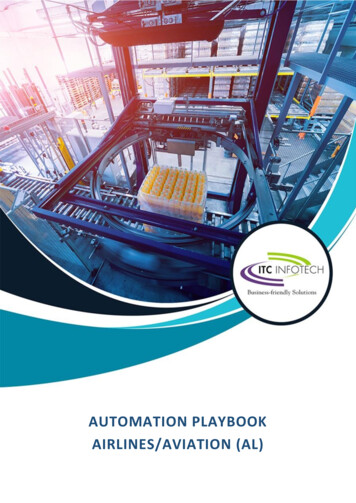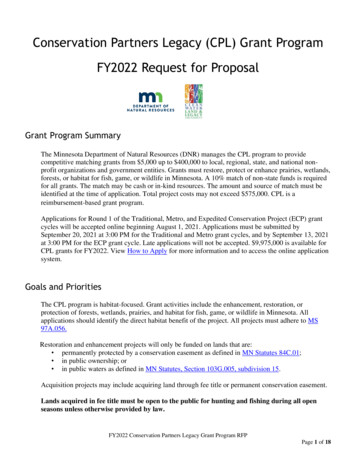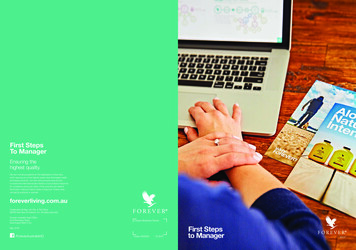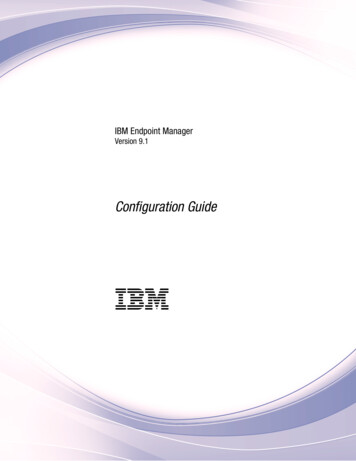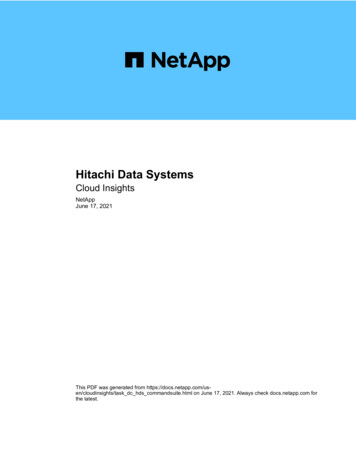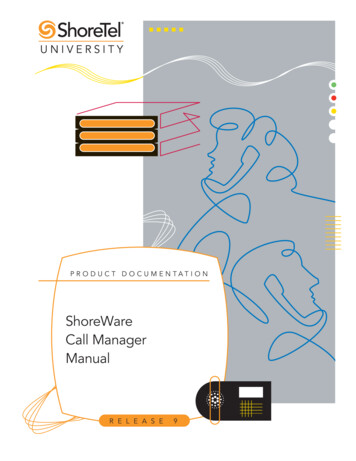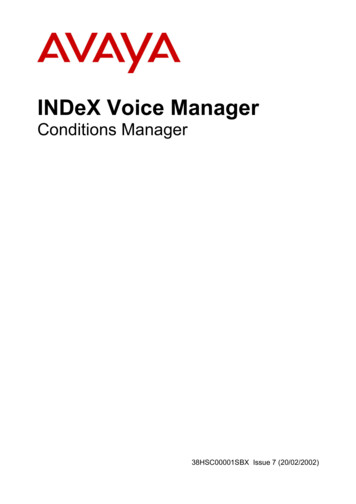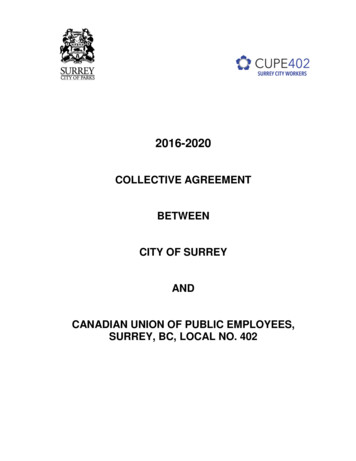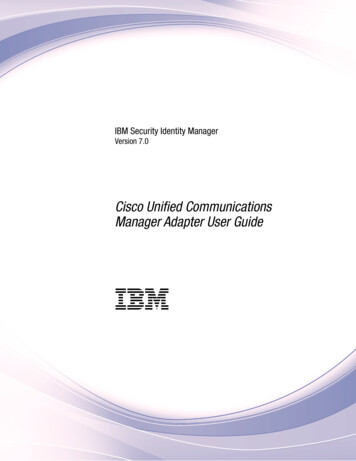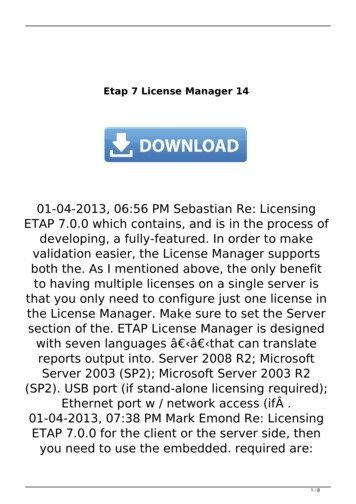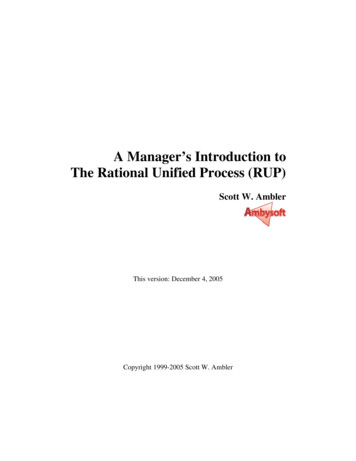
Transcription
A Manager’s Introduction toThe Rational Unified Process (RUP)Scott W. AmblerThis version: December 4, 2005Copyright 1999-2005 Scott W. Ambler
Executive SummarySoftware development is a complex endeavor, one which is fraught withperil if you do not follow a proven software method. The Rational UnifiedProcess (RUP) is one such method. The RUP takes an evolutionaryapproach to development which has been shown in practice to be far moreeffective than the traditional, serial “waterfall” approach which is prevalentin many organizations.This white paper overviews the lifecycle, phases, disciplines, and bestpractices of the RUP. It also provides suggested web-based resources whichyou may find useful if you are looking for more detailed information.Although written for managers, IT practitioners will also find this paper avaluable introductory resource to the RUP.AcknowledgementsI would like to thank Peter Alfvin, Rob Exley, Mark Lines, and FrankSchophuizen for their insightful feedback which I have incorporated into thispaper.
Table of Contents1Serial in the Large. 21.1The Inception Phase. 31.2The Elaboration Phase . 31.3The Construction Phase . 41.4The Transition Phase . 41.5Examining the Four Phases. 52Iterative in the Small. 62.1The Business Modeling Discipline . 62.2The Requirements Discipline. 72.3The Analysis and Design Discipline. 72.4The Implementation Discipline . 82.5The Test Discipline. 82.6The Deployment Discipline . 92.7The Configuration and Change Management Discipline . 92.8The Project Management Discipline. 102.9The Environment Discipline. 102.10 Making Iterations Work in Practice. 103Delivering Incremental Releases Over Time. 114Following Proven Best Practices . 134.1Adapt the Process. 134.2Balance Competing Stakeholder Priorities . 134.3Collaborate Across Teams . 144.4Demonstrate Value Iteratively . 144.5Elevate the Level of Abstraction . 154.6Focus Continuously on Quality . 155Why the RUP? . 166The RUP as a Process Framework. 177Concluding Remarks. 18
The IBM Rational Unified Process (RUP) is a prescriptive, well-defined system developmentprocess, often used to develop systems based on object and/or component-based technologies. Itis based on sound software engineering principles such as taking an iterative, requirementsdriven, and architecture-centric approach to software development (Kruchten 2004). It providesseveral mechanisms, such as relatively short-term iterations with well-defined goals and go/nogo decision points at the end of each phase, to provide management visibility into thedevelopment process.Figure 1 depicts the RUP lifecycle, commonly referred to as the “hump chart” diagram. Thehorizontal “humps” for each discipline give a rough estimate of the relative effort for eachthroughout the four phases. For example you can see that a large portion of Business Modelingtakes place in Inception, although it does continue through to early Transition. Work ondeployment usually does not start until Elaboration and doesn’t really kick into high gear untilthe middle of Construction. The hump chart is a visual mechanism to provide a rough overviewof how much each discipline is executed in each phase.Figure 1. The RUP v2003 lifecycle1.1This diagram is Copyright 1999-2005 IBM.Copyright 1999-2005 Scott W. AmblerPage 1
IBM Rational has made, and continues to make, a significant investment in the RUP.In November 2005 IBM Rational announced that the RUP product (IBM 2004), along withSummit Ascendant (another IBM-owned software process), would evolve into Rational MethodComposer (RMC). RMC is an Eclipse-based tool which enables you to define, maintain, anddeploy software process related material (Kroll 2005). Although RMC now forms the softwareprocess product offering from IBM Rational going forward, RUP as a process framework willstill continue.I like to characterize the RUP lifecycle as:1. Serial in the large2. Iterative in the small3. Delivering incremental releases over time4. Following proven best practices.1 Serial in the LargeThe RUP is structured in two dimensions: phases, which represents the four major stages that aproject goes through over time, and disciplines, which represent the logical activities that takeplace throughout the project. The serial aspect of the RUP is captured in its phases and theiterative nature of the RUP by its disciplines. You see in Figure 1 that the four phases –Inception, Elaboration, Construction, and Transition – are listed across the top of the lifecycle.Phases are the “Seasons” of a ProjectGary Evans, of Evanetics (www.evanetics.com), likes to compare the phasesof a RUP project to the seasons of the year. For example, during Inceptionyou’ll do the same sorts of activities that you do during Construction, but theextent that you do them, and the order in which you do them may change.During Inception a project team will spend a lot of time writing initial, pointform use cases in order to understand the scope of their system, but if theywrite any code at all it is likely for user interface (UI) prototyping. DuringConstruction any use case work will likely be to finalize the definition of a usecase before writing the detailed source code which implements it. During bothphases you work on use cases and source code, but in different ways.Each phase ends with a well-defined milestone. At these points, the stakeholders assess theproject, including what has been done and the plans for moving forward. A go/no-go decision ismade about whether to proceed with the project. Each phase has a specific set of goals, whichare addressed within the iterations of the phase, so that the phase milestone may be met. Figure2 overviews the primary activities and milestones of each phase; each phase is explored in detailwithin the following sections. In many ways phases provide the glue which holds the RUPtogether, but the disciplines of the RUP (Section 2) capture its heart.
Figure 2. The RUP phases and their milestones.1.1 The Inception PhaseThe primary goals of the Inception phase are to achieve stakeholder consensus regarding theobjectives for the project and to obtain funding. To do this you will develop a high-levelrequirements model which will delimit the scope of the project, and potentially start thedevelopment of a user interface (UI) prototype. You will start to install the work environmentand tailor the process for the team. You will also develop a high-level plan for how the projectwill proceed. At the end of this phase you hold the Lifecycle Objectives (LCO) milestone whereyour stakeholders assess the state of the project and must agree:1. On the scope of the project2. That the initial requirements have been identified (albeit without much detail)3. That your software development plan is realistic4. That the risks have been identified and are being managed appropriately5. That the business case for the project makes sense6. That the development process has been tailored appropriately1.2 The Elaboration PhaseDuring the Elaboration phase you specify requirements in greater detail and prove thearchitecture for the system. The requirements are detailed only enough to understandarchitectural risks and to ensure that there is an understanding of the scope of each requirementfor subsequent planning. To prove the architecture you will implement and test an “end-to-endskeleton” of working code which supports the high-risk use cases for your system. At the end ofthis phase you must hold the Lifecycle Architecture (LCA) milestone review where yourstakeholders assess the state of the project and must agree that the:1. Project vision has stabilized and is realistic2. Requirements for the project (although they will still evolve)Copyright 1999-2005 Scott W. AmblerPage 3
3. Architecture is stable and sufficient to satisfy the requirements4. Risks are continuing to be managed5. Current expenditures are acceptable and reasonable estimates have been made for futurecosts and schedules6. Project team has a realistic chance to succeed7. Detailed iteration plans for the next few Construction iterations, as well as a high-levelproject plan, are in place1.3 The Construction PhaseThe focus of the Construction phase is to develop the system to the point where it is ready fordeployment. Emphasis shifts now to prioritizing requirements and completing their specification,analyzing them, designing a solution to satisfy them, and coding and testing the software. Ifnecessary, early releases of the system are deployed, either internally or externally, to obtain userfeedback. At the end of this phase you must hold the Initial Operational Capability (IOC) reviewwhere your stakeholders assess the state of the project and must agree that the:1. Software and supporting documentation are acceptable to deploy2. Stakeholders (and the business) are ready for the system to be deployed3. Risks are continuing to be managed effectively4. Current expenditures are acceptable and reasonable estimates have been made for futurecosts and schedules5. Detailed iteration plans for the next few Transition iterations, as well as a high-levelproject plan, are in place1.4 The Transition PhaseThe Transition phase focuses on delivering the system into production. There will be testing byboth system testers and end-users, and corresponding rework and fine tuning. Training of endusers, support, and operations staff is done. At the end of this phase you must hold the ProductRelease (PR) milestone review where your stakeholders assess the state of the project and mustagree that the:1. System, including supporting documentation and training, is ready for deployment2. Current expenditures are acceptable and reasonable estimates have been made for futurecosts3. System can be operated once it is in production4. System can be supported appropriately once it is in production
1.5 Examining the Four PhasesThere are five critical observations to be made concerning the RUP phases:1. Activities continue in each phase. Traditionalists will often mistakenly think that theInception phase corresponds to the traditional requirements phase, that Elaborationcorresponds to design, that Construction corresponds to coding, and that Transitioncorresponds to testing. Nothing could be further from the truth. Look at Figure 1 again –the nine disciplines (Section 2) cross into each phase. You’ll be designing, coding, andtesting in an iterative manner during all four phases.2. Work products evolve during each phase. Work products – models, plans, sourcecode, documents – evolve throughout the life of your project. Work products aren’tfinished until you release your system into production, in fact you may find that you’ll bedoing requirements modeling the day before you release.3. The project is planned in a rolling wave. With a rolling wave approach (Githens 1998)detailed planning is done for things closer to you (like the relative height of the crest of awave) and less detailed for things further away (the lack of height of the back side of awave). As your project progresses and tasks get closer detailed planning for them is done.4. Risk management is crucial to your success. IT professionals who state “we know therisks, there’s no need to document them” or “there’s so few risks, it’s not worth our timeto record them” are asking for trouble. Risks that are assumed to be “known” by everyoneare rarely understood to be the same by everyone. Risks that are few in number shouldentail a small amount of time to document so why not invest the miniscule effort. Simplygoing through the effort of thinking about risks and strategies to deal with them in orderto document them is time well spent.5. Each phase ends with a go/no-go decision. Your stakeholders must agree to moveforward into the next phase. This may entail reworking your strategy for running theproject, or they must agree to cancel the project. A project may be cancelled because it’snot acceptable due to quality concerns or lack of appropriate documentation, it is deemedtoo expensive to deploy and/or support, or the strategic direction for the company mayhave shifted. Although it is rare, it is possible that a project may even be cancelled at theend of Transition.Typical RUP projects spend approximately 10% of time in Inception, 25% in Elaboration, 55%in Construction and 10% in Transition, although these figures vary from organization toorganization and even from project to project. For example, a “green field” project in a newtechnical area may spend more time in Elaboration, for example, as the team addresses newarchitectural issues. A project that is heavily dependent upon business processing may spendmore time in Inception figuring out new business processes and how (or if) technology cansupport them. A project consisting of minor enhancements and fixes to an existing system mayspend very little time in Inception and Elaboration. The bottom line is that every project isdifferent and the process that it follows must be tailored to meet its needs.Copyright 1999-2005 Scott W. AmblerPage 5
2 Iterative in the SmallRUP phases are divided into one or more iterations, although the term “increment” would likelyhave been more appropriate. Iterations address only a portion of the entire system beingdeveloped (unlike the waterfall approach, which attempts to do it all at once). Each iteration hasa fine-grained plan with a specific goal. Iterations build upon the work done by previousiterations and assemble the final system incrementally. Iterations are indicated along the bottomof Figure 1 with each phase subdivided into one or more iterations. When an iteration ends, inparticular during the Construction phase, a small subset of the system has been completed whichcould conceivably be deployed to users as a release, even if only as an alpha or beta version.The iterative nature of the RUP is reflected in how you approach its disciplines, which arelogical grouping of activities that take place over the lifetime of a project. The heart of the RUPis truly in its disciplines, not its phases. During each iteration you will alternate back and forthbetween the activities of the disciplines, performing each task to the extent needed at the time, toachieve the goals of that iteration. In other words, during an iteration a portion of therequirements are selected, analyzed, designed, coded, tested and integrated with the productsfrom earlier iterations. The nine disciplines of the RUP are:1. Business Modeling2. Requirements3. Analysis and Design4. Implementation5. Test6. Deployment7. Configuration and Change Management8. Project Management9. Environment2.1 The Business Modeling DisciplineThe goal is to understand the business of the organization, usually confined to the scope of thebusiness that is relevant to the system being developed. Working closely with projectstakeholders, you will:1. Assess the current status of the organization, including your ability to support a newsystem2. Explore the current business processes, roles, and responsibilities3. Identify and evaluate potential strategies for reengineering the business processes4. Develop a domain model which reflects that subset of your businessSuggested ResourcesExtending the RUP with the Enterprise Business Modeling enterpriseBusinessModeling.html
2.2 The Requirements DisciplineThe goal is to elicit, document, and agree upon the scope of what is and what is not to be built.This information is used by analysts, designers, and programmers to build the system, by testersto verify the system, and by the project manager to plan and manage the project. Activities ofthe Requirements discipline include:1. Working closely with project stakeholders to understand their needs2. Defining the scope of the system3. Exploring usage, business rules, the user interface, and technical (non-functional)requirements via appropriate modeling techniques4. Identifying and prioritizing new or changed requirements as they are identifiedthroughout a projectSuggested ResourcesAgile Requirements Modeling Agile Requirements Best mentsBestPractices.htm2.3 The Analysis and Design DisciplineThe goal is to analyze the requirements for the system and to design a solution to beimplemented, taking into consideration the requirements, constraints and all applicable standardsand guidelines. Critical activities of this discipline include:1. Formulating, and then defining, a candidate architecture for a system2. Constructing a proof-of-concept, or spike, to validate a candidate architecture3. Understanding (analyzing) the requirements for the system4. Design of components, services, and/or modules5. Network, user interface, and database designSuggested ResourcesAgile Model Driven Development (AMDD) www.agilemodeling.com/essays/amdd.htmAgile Architectural Modeling Extending the RUP with an Enterprise Architecture enterpriseArchitecture.htmlCopyright 1999-2005 Scott W. AmblerPage 7
2.4 The Implementation DisciplineThe goal is to transform the design into executable code and to perform a basic level of testing,in particular unit testing. Primary activities include:1. Understanding and evolving the design model2. Writing program source code3. Implementing components, services, and/or modules4. Unit testing source code5. Integrating the code into subsystems and/or a deployable buildSuggested ResourcesIntroduction to Test Driven Development (TDD) www.agiledata.org/essays/tdd.htmlRefactoring Home Page www.refactoring.comThe Process of Database Refactoring air Programming Home Page pairprogramming.com2.5 The Test DisciplineThe goal is to perform an objective evaluation to ensure quality. This includes finding defects,validating that system works as designed, and verifying that the requirements are met. Criticalactivities include:1. Defining and planning testing efforts2. Developing test cases3. Organizing test suites4. Running tests5. Reporting defectsSuggested ResourcesThe Full Lifecycle Object-Oriented Test (FLOOT) Methodwww.ambysoft.com/essays/floot.htmlAgile Testing www.testing.com/agile/
2.6 The Deployment DisciplineThe goal is to plan for the delivery of the system and to execute the plan to make the systemavailable to end users. Activities within this discipline include:1. Planning the deployment strategy2. Developing support and operations material3. Creating deployment packages4. Organizing alpha/beta/pilot testing efforts5. Deploying software to installation sites6. Training end users7. Managing acceptance testing effortsSuggested ResourcesDevelopment Sandboxes: An Agile Best tem Deployment Tips and Techniques ies for Effective Training and Education in l2.7 The Configuration and Change Management DisciplineThe goal is to manage access to the project’s work products. This includes not only trackingversions over time but also controlling and managing changes to them. Critical activities of thisdiscipline include:1. Managing change requests2. Planning configuration control3. Setting up the CM environment4. Monitoring and reporting configuration status5. Changing and delivering configuration items6. Managing baselines and releasesSuggested ResourcesAgile Requirements Change ement.htmSCM Patterns for Agilitywww.scmpatterns.comCopyright 1999-2005 Scott W. AmblerPage 9
2.8 The Project Management DisciplineThe goal is to direct the activities that take place on the project. This includes managing risks,directing people (assigning tasks, tracking progress, etc.), and coordinating with people andsystems outside the scope of the project to be sure that it is delivered on time and within budget.Critical activities include:1. Initiating a new project2. Managing project staff3. Enhancing the relationship with external teams and resources4. Risk management5. Estimating, scheduling, and planning6. Managing an iteration7. Closing out a phase or projectSuggested ResourcesAgile Project Planning Tips xtending the RUP with the People Management peopleManagement.htmlScrum Home Page www.controlchaos.com2.9 The Environment DisciplineThe goal is to support the rest of the effort in terms in ensuring that the proper process, guidance(standards and guidelines), and tools (hardware, software, etc.) are available for the team asneeded. The critical activities of this discipline are:1. Tailoring the process materials for an individual project team2. Identifying and evaluating tools3. Installing and setting up tools for the project team4. Supporting the tools and process throughout a projectSuggested ResourcesExtending the RUP with the Software Process Improvement softwareProcessImprovement.html2.10 Making Iterations Work in PracticeAn important concept when working within an iteration is that work does not proceed strictlyserially, as it does in a waterfall approach. Yes, you still start with requirements, performanalysis, design and code but you do not have to finalize one before you can move on the next. Amore normal approach is to address some subset of the requirements, do some analysis, go back
and re-work some of the requirements, move to design, re-work some requirements and/oranalysis, start coding, re-work the design. In order for this to work, you need a team that workstogether on projects. Requirements people need to work with designers who work with coderswho work with testers. Of course this works best if the same people can perform requirementsanalysis, design, coding and test but it’s not strictly necessary. The important point is that workproceeds in a serial nature in the broader sense but that work products are not finished andhanded off but revised as needed by latter phases.Iterations are planned according to risks. Higher priority risks are addressed in earlier iterationswhile lower priority risks are addressed later. This is at the heart of a risk-management approachto developing software.Iterations that are near-term are planned in greater detail than longer-term iterations. The longerterm iterations may change in scope or goal depending on what happens in earlier iterations.Planning for iterations further down the line should be assumed to be of lower accuracy with ahigher degree of variance based on current information; information that may change and causechanges to iteration planning. That does not mean that planning for later iterations should betaken lightly. It just means that the best planning based on current data should be done but thatthings may change before the iteration is realized. That is the reason that longer-term iterationplans are coarse-grained; the situation may very well change so it is often not productive toattempt to plan in detail. It can, in fact, be misleading to stakeholders and others if you attempt toplan work that is far in the future with any specificity.3 Delivering Incremental Releases Over TimeThe first version of a system is usually not the final version. If that were so, every system wouldremain version 1.0. Instead, systems evolve over time. New functionality is added, userrequested enhancements are added, new standards are adopted and supported, etc. In the RUP apass through the four RUP phases creates a single version of a system called a productionrelease.During or after the Transition phase a new project may be started to address any outstandingrequirements. The new project may begin at the Inception phase again although some teams maydecide to start in the Elaboration phase or even the Construction phase if appropriate. As Figure3 depicts this can continue indefinitely, as long as new requirements are identified that thestakeholders agree are worthy of a new version of the software.Copyright 1999-2005 Scott W. AmblerPage 11
Figure 3. The incremental release of a system into production.
4 Following Proven Best PracticesIn the past the original best practices (develop iteratively, manage requirements, usecomponent architecture, model visually (UML), continuously verify quality, and managechange) reflected software development issues. In October 2005 IBM announced a revised listof best practices for the RUP which takes into account the overall “business picture” ofcontinuously evolving systems (Kroll and Royce, 2005). These best practices are:1.2.3.4.5.6.Adapt the process.Balance competing stakeholder priorities.Collaborate across teams.Demonstrate value iteratively.Elevate the level of abstraction.Focus continuously on quality.4.1 Adapt the ProcessThis practice reflects one of my fundamental philosophies, that you need to follow the rightprocess for the job. Every person, project team, and organization is different as is theenvironment in which they work. One process size does not fit all, instead you need to tailoryour software process to meet your exact needs. If you try to adopt RUP “straight out of thebox” you are very likely going to fail – there is far more material in the RUP than any projectteam needs, and you will often discover that the RUP will be missing a few things which arepertinent to your situation. You must adapt the RUP appropriately.Suggested ResourcesChoose the Right Software Method for the mlExtending the RUP with a Software Process Improvement softwareProcessImprovement.html4.2 Balance Competing Stakeholder PrioritiesAny development project will have a variety of stakeholders – end users, business management,operations staff, enterprise architects, external customers, and so on – and they will havedifferent needs and priorities. One of the hardest parts of software development is to balancethose priorities, particularly when they often change as your project progresses. By taking anevolutionary approach to development where your stakeholders are active participants you aremuch more likely to achieve your goal of building high-quality, working software which meetsyour stakeholders needs.Copyright 1999-2005 Scott W. AmblerPage 13
Suggested ResourcesActive Stakeholder akeholderParticipation.htmAgile Requirements Change ement.htm4.3 Collaborate Across TeamsSoftware is developed by talented, motivated people who communicate and collaborateeffectively. To achieve this successfully, you need to motivate people to not only do their best,but also to actively learn new skills from their co-workers and other sources (such as trainingclasses, books, and web sites). My experience is that the best developers are generalizingspecialists, people with one or more specialties (such as writing Java code or design modeling), abroad understanding of software development in general, and an understanding of the domain inwhich they work. With this broad understanding of development and the domain, generalizingspecialists are better suited than specialists to collaborate effectively with other people, therebynot only getting the job done but usually learning new skills in the process.To foster effective collaboration, your organization must provide effective tools and workingenvironment. Although nice offices and private cubicles are nice, they effective erect a barrier tocommunication between people and hamper their ability to collaborate effectively. A betterstrategy is to co-locate both developers and stakeholders together, or at least in very closeproximity, to foster communication. You should also adopt tools and practices which fostersharing of information, including effective configuration management tools and the practice ofshared work products across the team (the team “owns” a document, not an individual).Suggested ResourcesCommunication on Agile Software Projectswww.agilemodeling.com/e
IBM Rational has made, and continues to make, a significant investment in the RUP. In November 2005 IBM Rational announced that the RUP product (IBM 2004), along with Summit Ascendant (another IBM-owned software process), would evolve into Rational Method Composer (RMC). RMC is an Eclipse-based tool which enables you to define, maintain, and
